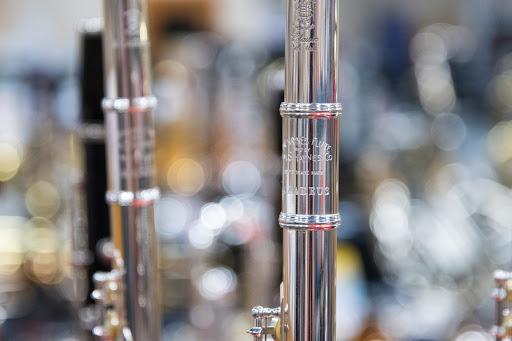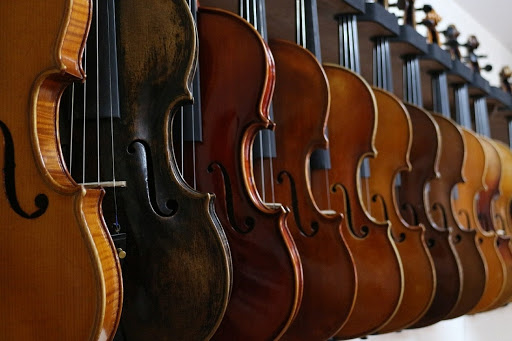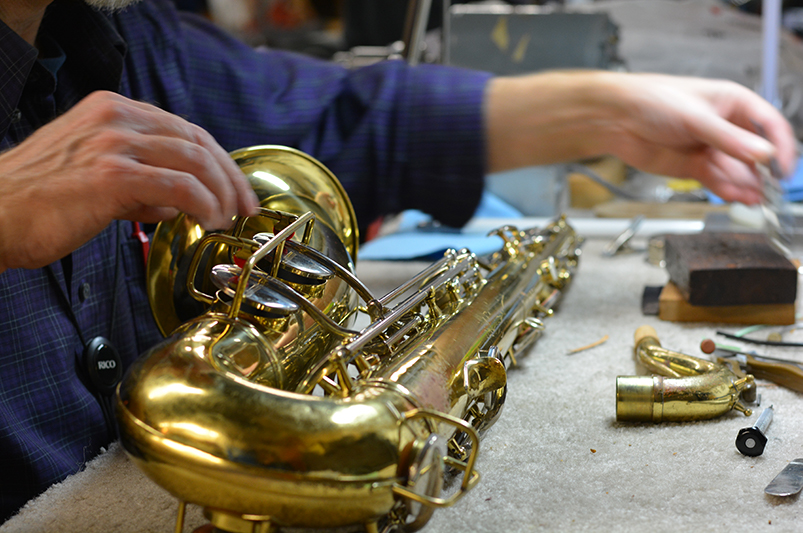You need to do some more shopping! Your shopping cart is currently empty.
If there’s one thing that can put a kink in an aspiring musician’s strut, it’s a malfunctioning instrument. Luckily, there are some basic things we can do (and should do!) to make sure our instruments stay in top playing condition.
Brass Instruments

Daily:
Empty all excess water from the horn before putting it back in the case
Spit valves aren’t just for grossing out the flute section. Spit causes mineral buildup and will cause your horn to malfunction.
Check all tuning slides for smooth operation
Make sure the tuning slides move smoothly. If not, wipe ‘em with a clean cloth and apply slide grease. A bit of vigilance goes a long way toward gunk prevention. Also, inspect for dents, and loose braces and joints. If you find any, take your instrument to a professional to sort them out.
Wipe down the outside with a soft cloth
Clean the outside of your horn everyday, but especially after applying grease or oil. No one wants an ugly horn.
Weekly:
Clean the inside and outside of the mouthpiece with conical brush
Otherwise, minerals from your spit will build up, restrict airflow, and general gross people out.
Lubricate all tuning slides with tuning slide grease
An ounce of prevention is worth a pound of cure. Regularly lube your slides and you’ll stave off sticking.
Monthly:
Give your horn a bath
(Horns only! Don’t submerge woodwinds!)Pull out all tuning slides and remove all valves, except rotary valves. Remove the valve caps and any felts, but not the stems. Submerge all metal parts in lukewarm water with a bit of mild dish soap (like Dawn).
After five minutes of soaking, scrub the insides of all tubing with a snake brush and scrub the valve casings with a valve casing brush. Then rinse, air-dry and reassemble.
Flutes

Daily:
Wipe off the tenon
If your joints are tough to assemble, wipe down the tonon. Feel free to use a bit of rubbing alcohol to get it nice and clean.
Wipe off the outside of the instrument with a silver polish cloth
Flutes are graceful instruments. They like to be shiny.
Dry the inside of the instrument with a swab every time you finish playing
Have you noticed that saliva is the enemy? If you don’t dry the inside each time you play, the pads will build up mineral deposits, causing them to stick and wear faster than normal.
Weekly:
Clean around all keys and rods with a key brush
Get in there and clean that gunk you missed during your daily wiping.
Use pad paper on sticky keys
Keys sticking? Just hold a sheet of pad paper between the pad for 10 seconds. Then pull the paper out while applying slight pressure to the key. Repeat as needed.
Reed Instruments

Daily:
Check cord joints
If they aren’t sliding in smoothly, add some cork grease.
Remove the reed
Done playing? Put that reed in a nice, safe reed guard.
Swab away the moisture
You know the drill. Moisture means buildup. Buildup is bad. Swab it.
Weekly:
Wash your mouthpiece
Wash it with lukewarm water and scrub with a mouthpiece brush. Feel free to use a touch of soap.
Apply cork grease to tenon corks
Keep those corks greased, or they will dry out, causing friction and tearing upon reassembly.
Clean tone holes and between keys and rods
Use a key brush to get rid of any buildup.
Use pad paper on stickies key
Keys sticking? Just hold a sheet of pad paper between the pad for 10 seconds. Then pull the paper out while applying slight pressure to the key. Repeat as needed.
Monthly:
Oil your instruments body - (Wooden Instruments Only)
Sprinkle several drops of bore oil on a soft cloth and run through the entire inside of the instrument. Then, apply a few drops of bore oil on a different cloth and lightly apply to all outside parts of the instrument. Be careful to not get any oil on the pads!
String Instruments

Daily:
Loosen the bow hairs before putting the bow in the case
If you don’t ease the tension when your bow is not in use, it will gradually become warped. As you loosen the hairs, you’ll see the bow straighten a bit. That’s the look of a happy bow at rest.
Wipe off the outside of the instrument with a soft cloth
Not only will this make your instrument sparkle and shine, gunky buildup on the instrument can wear through the varnish.
Check for cracks and bring it in for repairs as needed
Several things can cause cracks to gradually form in the wood of your instrument. Keep an eye on it and have a professional take care of them if cracks appear.
Weekly:
Remove rosin buildup
Apply a small amount of rosin remover to a soft cloth and wipe under the strings and around the bridge, where dust collects. Don’t apply rosin remover to the strings themselves!
Check pegs for slippage
Fine adjustments are difficult if your pegs are slipping or difficult to move. If that happens, use a small amount of peg dope to give you more control over your pegs.
Make sure chin rest and bride are in the proper place
It’s a matter of comfort. Make sure these pieces are still working for you.
Annually:
Replace your strings
OK, you really ought to do this more often than annually, but different instruments and different players will have different needs when it comes to how often they change their strings. Dead strings produce dull sounds. And your playing should be anything but dull. Change your strings as needed, and ask yourself yearly, "When’s the last time I treated myself to some new strings?"
All Instruments

Never put anything in the case on top of the instrument
Cases are molded specially for the instrument they hold, and anything placed on top of them will add pressure to keys and tubing, causing the instrument to go out of adjustment more quickly. Place cleaning supplies in the cutouts or pouches of the case.
Get a yearly checkup
Instruments are mechanical devices, and they go out of adjustment. At the end of the school year is a great time to get a tune-up. Most repair shops will be able to get it in and out much quicker than at the beginning of the school year.


